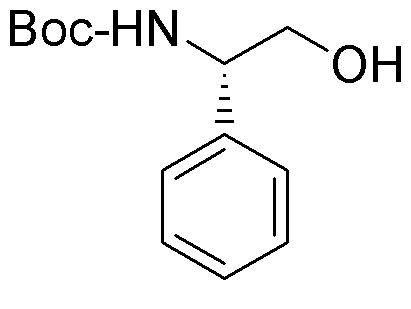Boc-L-phenylglycinol is widely utilized in research focused on:
- Pharmaceutical Development: This compound serves as a key intermediate in the synthesis of various pharmaceuticals, particularly in the development of drugs targeting neurological disorders.
- Peptide Synthesis: It is commonly used in solid-phase peptide synthesis, enhancing the stability and solubility of peptides, which is crucial for drug formulation.
- Chiral Auxiliary: The compound acts as a chiral auxiliary in asymmetric synthesis, allowing chemists to produce enantiomerically pure compounds more efficiently.
- Research in Organic Chemistry: It is utilized in organic synthesis for creating complex molecules, aiding researchers in exploring new chemical reactions and pathways.
- Biochemical Applications: Boc-L-phenylglycinol is applied in the study of enzyme mechanisms and interactions, providing insights into biochemical processes and potential therapeutic targets.
General Information
Properties
Safety and Regulations
Applications
Boc-L-phenylglycinol is widely utilized in research focused on:
- Pharmaceutical Development: This compound serves as a key intermediate in the synthesis of various pharmaceuticals, particularly in the development of drugs targeting neurological disorders.
- Peptide Synthesis: It is commonly used in solid-phase peptide synthesis, enhancing the stability and solubility of peptides, which is crucial for drug formulation.
- Chiral Auxiliary: The compound acts as a chiral auxiliary in asymmetric synthesis, allowing chemists to produce enantiomerically pure compounds more efficiently.
- Research in Organic Chemistry: It is utilized in organic synthesis for creating complex molecules, aiding researchers in exploring new chemical reactions and pathways.
- Biochemical Applications: Boc-L-phenylglycinol is applied in the study of enzyme mechanisms and interactions, providing insights into biochemical processes and potential therapeutic targets.
Documents
Safety Data Sheets (SDS)
The SDS provides comprehensive safety information on handling, storage, and disposal of the product.
Product Specification (PS)
The PS provides a comprehensive breakdown of the product’s properties, including chemical composition, physical state, purity, and storage requirements. It also details acceptable quality ranges and the product's intended applications.
Certificates of Analysis (COA)
Search for Certificates of Analysis (COA) by entering the products Lot Number. Lot and Batch Numbers can be found on a product’s label following the words ‘Lot’ or ‘Batch’.
*Catalog Number
*Lot Number
Certificates Of Origin (COO)
This COO confirms the country where the product was manufactured, and also details the materials and components used in it and whether it is derived from natural, synthetic, or other specific sources. This certificate may be required for customs, trade, and regulatory compliance.
*Catalog Number
*Lot Number
Safety Data Sheets (SDS)
The SDS provides comprehensive safety information on handling, storage, and disposal of the product.
DownloadProduct Specification (PS)
The PS provides a comprehensive breakdown of the product’s properties, including chemical composition, physical state, purity, and storage requirements. It also details acceptable quality ranges and the product's intended applications.
DownloadCertificates of Analysis (COA)
Search for Certificates of Analysis (COA) by entering the products Lot Number. Lot and Batch Numbers can be found on a product’s label following the words ‘Lot’ or ‘Batch’.
*Catalog Number
*Lot Number
Certificates Of Origin (COO)
This COO confirms the country where the product was manufactured, and also details the materials and components used in it and whether it is derived from natural, synthetic, or other specific sources. This certificate may be required for customs, trade, and regulatory compliance.


